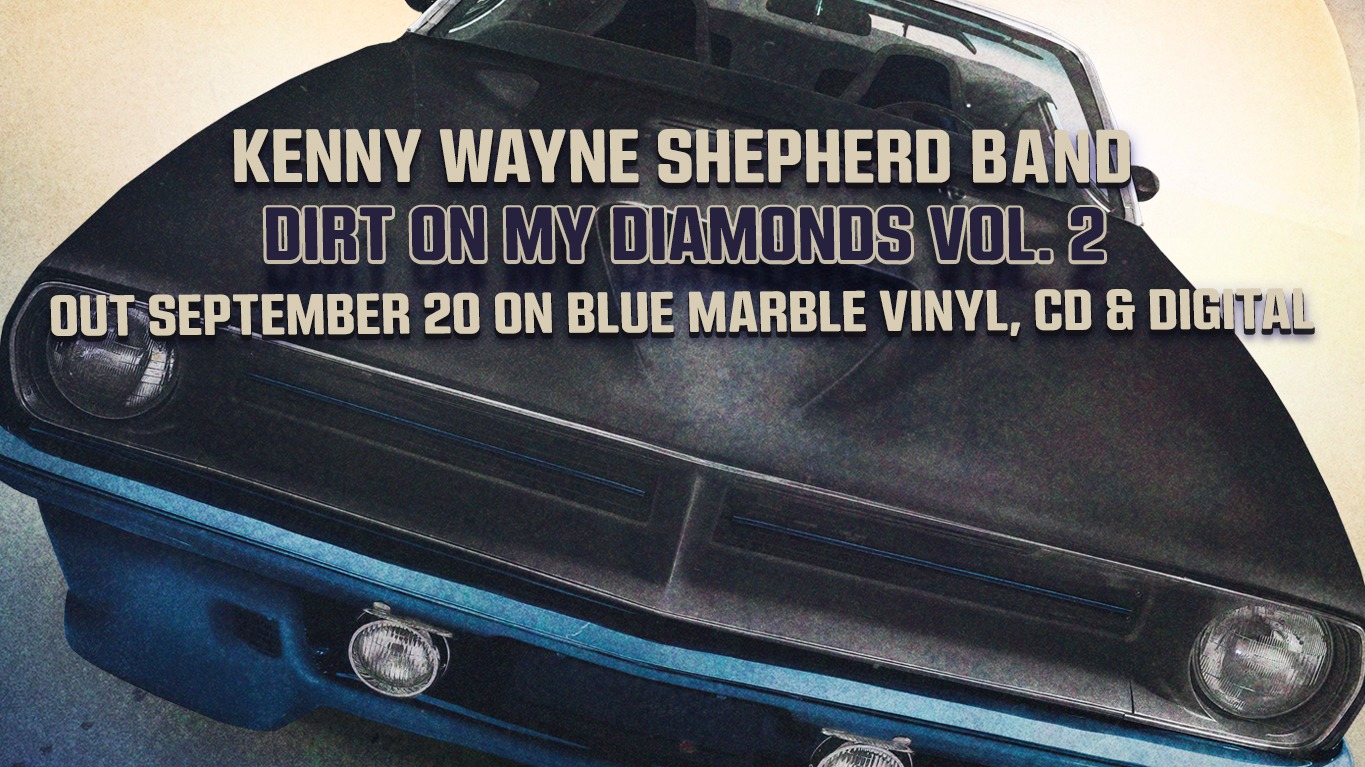
AMERIKANSK SUPERGITARIST KENNY WAYNE SHEPHERD (us) TIL SKÅNEVIK BLUESFESTIVAL❤️💙
Some creative streaks are so hot, they can’t be satisfied by one album alone. In a rare career first for a multi-platinum, Grammy-nominated global superstar who has seen and done it all, Kenny Wayne Shepherd is set to release Part II of his Dirt On My Diamonds vision.
With the acclaimed Dirt On My Diamonds Vol 1 released only last November, Shepherd’s fans are still poring over that first slug of stellar material (“There’s no denying the impact,” wrote Classic Rock, “when he lets the blues off the leash”). But the Louisiana-born bandleader always had a bigger plan. Holding back a second set of songs birthed at the same writing sessions at FAME Studios in Muscle Shoals, Alabama, he now presents a follow-up record that is a very different animal, with shared DNA.
“When I started writing all of these songs, I started to see two individual identities emerge,” explains Shepherd of Dirt On My Diamonds Vol 2, released 20th September on Mascot/Provogue Records. “You’ll hear the same spirit across both albums, but the songs, sounds and grooves are very different. Because of the way that people live and consume music now, we decided to stagger the releases – but it’s essentially a double album. We had creative momentum on our side, so we just wanted to keep it rolling.”
The truth is that Shepherd hasn’t stopped rolling since his first release, Ledbetter Heights. Born and raised in North Louisiana – and steeped in classic blues and rock ‘n’ roll by his radio-personality dad – his vocabulary took in Muddy Waters, Albert King, Jimi Hendrix and Stevie Ray Vaughan.
The road became Shepherd’s classroom, and the back of the van his world, as he worked the circuit and wowed audiences at clubs that couldn’t legally serve him a beer. And after footage of the still-teenage guitarist tearing up a local festival made its way to Giant Records founder Irving Azoff, Shepherd found himself inking a multi-album deal with the Warner Brothers subsidiary. In 1995, Ledbetter Heights opened his studio account in style, followed by 1997’s Trouble Is… writing such startlingly mature hits as Blue On Black (62 million streams and counting). “It was vindication,” he says today.
As the millennium turned, there was no stopping Shepherd, who pinballed from 1999’s Live On to 2004’s The Place You’re In, before standing shoulder-to-shoulder with greats like B.B. King, Hubert Sumlin and Pinetop Perkins on 2007’s Grammy-nominated album/documentary Ten Days Out: Blues From The Backroads. “I always felt like I owed it to the great blues artists that came before me and the impact they had on me,” he says, “because otherwise you’re doing them a disservice.”
Twice in the past decade, he has ducked out for albums with his blues-rock supergroup The Rides (cofounded with Stephen Stills and Barry Goldberg). But Shepherd’s solo career has always been the main event, and having worked with Marshall Altman on 2017’s Lay It On Down and 2019’s The Traveler, the bandleader turned to him again to help to capture the “fresh, modern and current vibes” of the two-part Dirt On My Diamonds project.
As with the original release, Vol 2 came to life during those FAME writing sessions of 2019, with Shepherd spit balling ideas alongside the best writers in the business, and holding his songs to the lofty standards demanded by that musical landmark. “The whole reason we went down to Muscle Shoals,” he reflects of the recording space that has hosted everyone from Aretha Franklin to Little Richard, “was to soak up the vibe that’s been left in that room for so many decades. What am I like in the studio? I’m a hard worker. I’m not there to party. It’s not a big hang for me. From the moment I walk in the door until the moment I leave, I’m there to work. I’m a man on a mission, if you will.”
When the time came for tracking, they hit the Band House Studios in Los Angeles, just days before the bulldozers moved in. “It was a really cool, intimate, old-school studio with analogue everything, but they tore it down straight after we made these records,” sighs Shepherd. “There was no rhyme or reason to the sessions. I’d judge the mood of the room then just call out the song I felt was appropriate for that moment. The track listing for each album came into focus the more we started to complete different songs. You ask yourself, ‘What will take the listener on a cohesive musical journey?’”
The track listing roars to life with the purposeful stomp of I Got A Woman, Shepherd’s insistent riff carried aloft by a hard-blowing horn section. “To me, that’s the answer song to the first track on The Traveler, Woman Like You,” he explains. “On that song, the guy is admiring this woman. Now, you get to this record, and he’s got her and she’s everything he hoped she would be. She’s so wonderful, in fact, that he knows that everywhere they go, people are paying attention to her.
“I really like the guitar sound on I Got A Woman,” Shepherd continues of the gutsy riffs performed on his best-selling signature Fender Stratocaster, “but one of the main differences between this new record and the first one are the horn arrangements. They really elevate these songs. Like, on the second track, The Middle, there’s also a really heavy horn presence and a funky groove that’s very different for us. As for the lyrics, I try not to veer off into politics much, because I believe I’m here to entertain and not be an unelected official. But that song has a few observations, because it’s impossible to live in the world today and not do that.”
The band then takes a breath with the gorgeous, glistening hard-luck story of My Guitar Is Crying. “Just a beautiful song,” nods Shepherd. “I have to give a lot of the credit to co-writer James LeBlanc. He birthed that idea in the studio and we developed it as a group. That song speaks to the many moments I’ve had through my life where you feel like the only thing that’s there for you is your guitar. But in this song, it’s such a dire, sad situation that even the guitar is moaning.”
The mood gets heavier with the gravel-flecked Long Way Down (“That’s the least flashy guitar solo on the entire record – it’s some very select notes, no flurry”), before the driving soul of Never Made It To Memphis spins a hilarious travelogue of a man chasing a girl across the States. “It’s a pursuit situation that never works out,” explains Shepherd. “Every turn the guy takes, nothing pans out exactly the way he thinks it’s going to. But in the end, he winds up with the girl, so everything is OK, regardless of all the wrong turns in the journey.”
Watch You Go is a flash of classic nudge-wink blues humour, set off by a stinging guitar solo (“It’s based on the saying, ‘I hate to see you leave, but I sure do love to watch you go’, and that guitar solo has a Leslie speaker effect, which makes it sound kinda frantic”). Spin Pressure in any club, meanwhile, and you’ll fill the dancefloor, with Shepherd dropping perhaps the funkiest groove in his entire catalogue. “That song is speaking to the society we live in,” he says. “Everyone is thinking about their social media count, showing off their vacations, their selfies. It’s just a relentless pursuit of something that’s never going to make you happy.”
And finally, while Vol 1 included a roaring cover of Elton John’s Saturday Night’s Alright For Fighting, Vol 2 takes ZZ Top’s She Loves My Automobile for a spin. “It speaks to my passion for beautiful cars,” says Shepherd, whose garage houses an impressive fleet of muscle cars. “But I always enjoyed the ZZ Top songs that incorporate Billy Gibbons’ love for automobiles. I always admired how he’s so crafty at writing songs that blend his passions and don’t come across as cheesy.”
Forced to hold back new material for the first time in his storied career, Shepherd will admit that keeping these latest songs under wraps has been torture (“They’re sounding great in rehearsals and we’ve been dying to get out there and play them”). Now, at last, the standard-bearer for 21st century rock ‘n’ roll is ready to put the cherry atop the Dirt On My Diamonds project with Vol 2.
“These are two unique albums that stand on their own,” he considers, “but together, I think they make for such a compelling package. We’ve had tremendous success in my career so far, and I’m so surprised and grateful for that. But even now, I still feel like there’s always more to explore musically. I just want to keep pushing the limits…”

